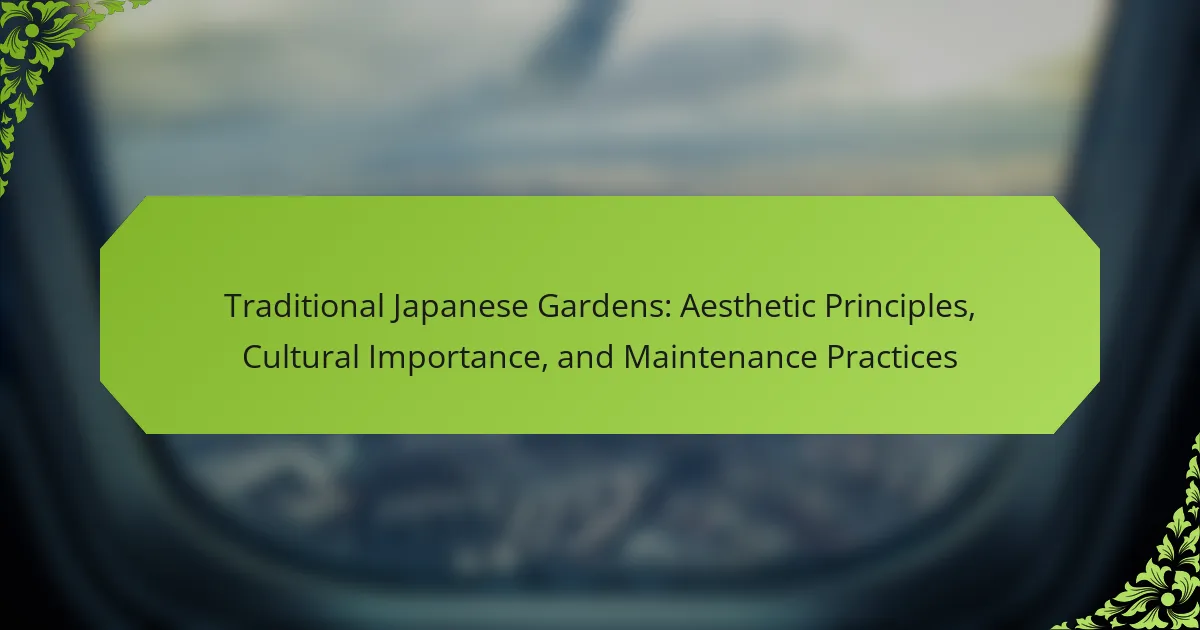Traditional Japanese gardens offer a unique blend of aesthetic principles, cultural significance, and maintenance practices that foster tranquility and reflection. Key principles include simplicity, naturalness, and asymmetry, which create serene landscapes. These gardens embody philosophical concepts from Zen Buddhism, emphasizing mindfulness and harmony with nature. Effective maintenance practices ensure their beauty and cultural relevance are preserved over time.
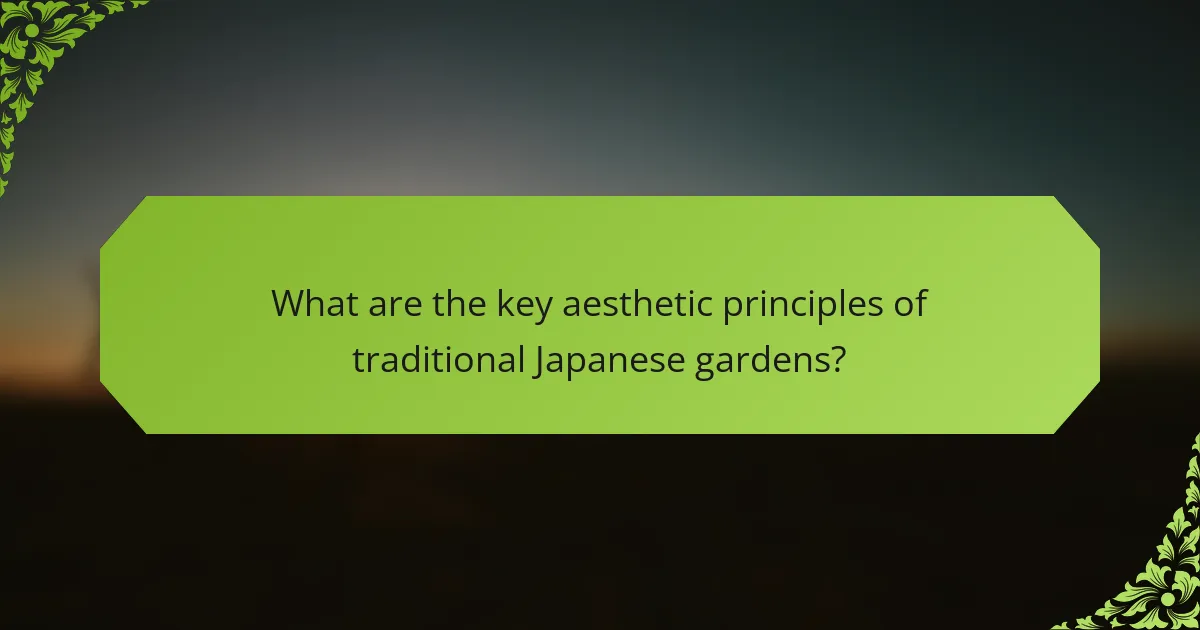
What are the key aesthetic principles of traditional Japanese gardens?
The key aesthetic principles of traditional Japanese gardens are simplicity, naturalness, and asymmetry. These gardens emphasize harmony with nature, using elements like water, rocks, and plants to create serene landscapes.
Simplicity is achieved through minimalism, allowing the viewer to focus on essential elements. Naturalness involves incorporating native plants and materials, reflecting the surrounding environment. Asymmetry creates balance and movement, steering away from rigid symmetry to evoke a sense of tranquility.
Additionally, traditional Japanese gardens often feature symbolic elements, such as stones representing mountains or water symbolizing purity. These principles collectively foster a meditative space that encourages reflection and appreciation of nature.
How do elements like water, rocks, and plants contribute to garden design?
Water, rocks, and plants play essential roles in traditional Japanese garden design. Water symbolizes purity and tranquility, often represented through ponds or streams. Rocks provide structure and represent mountains or islands, creating a sense of permanence. Plants introduce color and life, embodying seasonal changes and harmony with nature. Together, these elements foster a serene environment that reflects cultural values and aesthetic principles.
Why is asymmetry important in Japanese garden aesthetics?
Asymmetry is crucial in Japanese garden aesthetics because it reflects natural irregularities and creates a sense of balance. This design principle fosters harmony, inviting contemplation and connection with nature. It emphasizes the beauty of imperfection, aligning with the cultural philosophy of wabi-sabi. As a result, gardens appear more organic and less contrived, enhancing their tranquil atmosphere.
Which styles of traditional Japanese gardens are most prevalent today?
The most prevalent styles of traditional Japanese gardens today include Zen gardens, stroll gardens, and tea gardens. Zen gardens emphasize minimalism and meditation, often featuring rocks and gravel. Stroll gardens incorporate paths that guide visitors through various landscapes, showcasing seasonal changes. Tea gardens create serene spaces for tea ceremonies, integrating natural elements to enhance tranquility. Each style reflects unique aesthetic principles and cultural significance, contributing to Japan’s rich garden heritage.
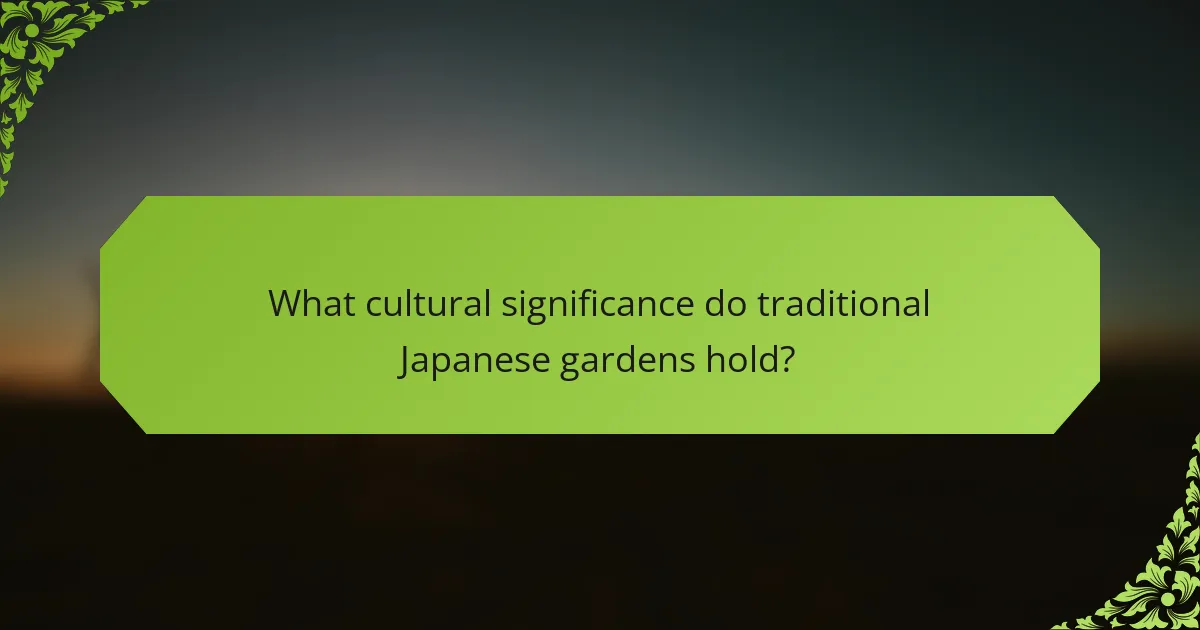
What cultural significance do traditional Japanese gardens hold?
Traditional Japanese gardens hold profound cultural significance, embodying harmony, tranquility, and a deep connection to nature. These gardens reflect philosophical principles such as Zen Buddhism, emphasizing simplicity and mindfulness. Their design incorporates elements like water, stones, and plants to create a miniature landscape that symbolizes larger natural vistas.
The aesthetic principles in these gardens often aim to evoke seasonal changes and provoke contemplation. For instance, the careful arrangement of rocks and plants represents mountains and rivers, fostering a sense of balance and peace.
Maintenance practices are integral to preserving their cultural importance. Regular care ensures that the gardens remain a space for reflection and connection, aligning with the Japanese value of appreciating the transient beauty of nature. This ongoing stewardship reinforces the gardens’ role as living art forms, continually evolving with the seasons.
How do gardens reflect Japanese philosophy and spirituality?
Traditional Japanese gardens embody harmony, simplicity, and nature’s beauty, reflecting deep philosophical and spiritual values. These gardens emphasize balance, often using asymmetry to mirror the natural world. The use of elements like water, stones, and plants symbolizes life’s transience, encouraging contemplation and mindfulness. Zen principles further influence garden design, promoting tranquility and meditation. Cultural practices surrounding garden maintenance highlight respect for nature, reinforcing the connection between humans and the environment.
What role do traditional gardens play in Japanese festivals and ceremonies?
Traditional Japanese gardens play a crucial role in festivals and ceremonies by providing a serene backdrop that enhances cultural rituals. These gardens symbolize harmony and balance, reflecting the beauty of nature and seasonal changes. During festivals, elements like cherry blossoms and koi ponds serve as focal points for celebration, inviting reflection and appreciation of nature’s cycles. Their design principles emphasize simplicity and tranquility, fostering a spiritual connection that enriches communal activities. This unique attribute of gardens as spaces for both aesthetic enjoyment and cultural expression underscores their importance in Japanese traditions.
Which historical figures influenced the development of Japanese gardens?
Key historical figures influencing Japanese gardens include Zen monks, samurai, and influential poets. Zen monks, such as Dōgen, emphasized simplicity and naturalness, shaping the aesthetic principles of gardens. Samurai, valuing harmony and tranquility, contributed to the design and layout of gardens, integrating them into their estates. Poets like Matsuo Bashō inspired the incorporation of seasonal elements and evoking emotions through nature. These figures collectively established the cultural importance and maintenance practices of traditional Japanese gardens, reflecting a deep connection to nature and spirituality.
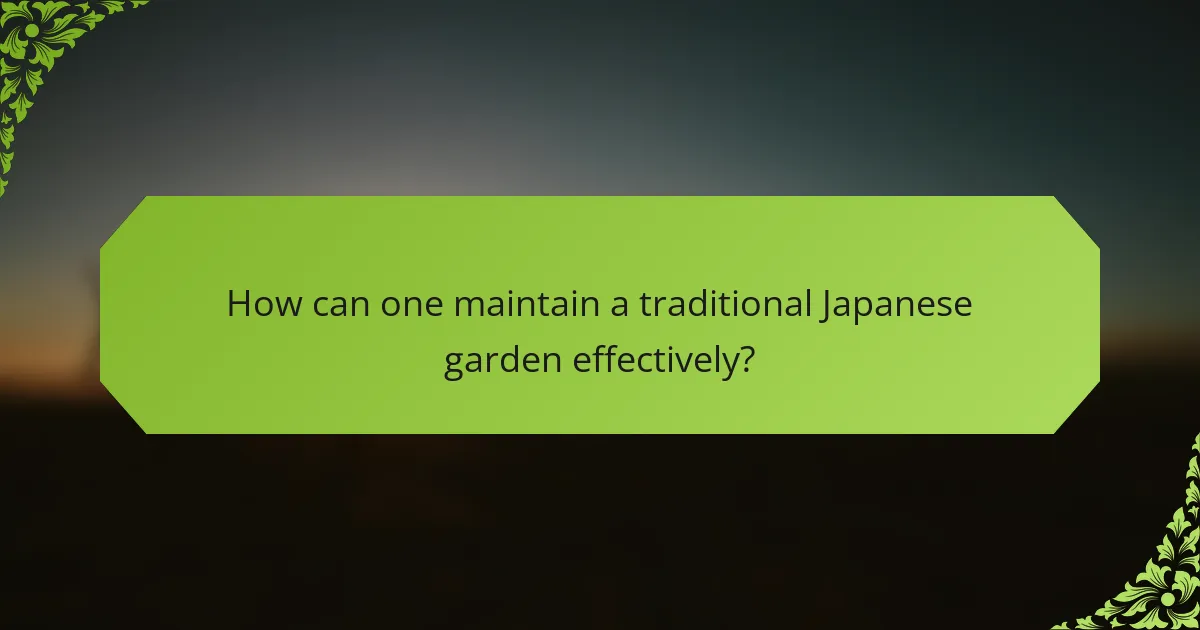
How can one maintain a traditional Japanese garden effectively?
To maintain a traditional Japanese garden effectively, focus on consistent care and respect for its aesthetic principles. Regularly prune trees and shrubs to preserve their shape and health. Rake gravel paths to maintain a serene appearance and prevent weeds. Monitor water features for cleanliness and balance, ensuring aquatic life thrives. Seasonal adjustments, such as planting seasonal flowers or adjusting stone placements, enhance visual harmony. Engage in mindful observation to appreciate the garden’s evolving beauty, fostering a deeper connection to nature.
What are the best practices for seasonal maintenance of garden elements?
Seasonal maintenance of traditional Japanese gardens involves specific practices to preserve their aesthetic and cultural significance. Regular pruning of trees and shrubs maintains their shape and encourages healthy growth.
Cleaning water features, such as koi ponds, prevents algae buildup and promotes a serene environment. Seasonal planting of flowers ensures vibrant colors throughout the year, while mulching protects soil moisture and suppresses weeds.
Additionally, inspecting pathways and stones for wear maintains safety and visual appeal. Implementing these practices enhances the garden’s tranquility and aligns with its cultural importance.
How does climate affect the maintenance of Japanese gardens in different regions?
Climate significantly influences the maintenance of Japanese gardens across different regions. In warmer areas, gardens require more frequent watering and shade for plants. Conversely, colder regions necessitate protective measures against frost and snow. Humidity levels also affect plant selection and soil management practices. For instance, coastal gardens may thrive with salt-tolerant species, while mountainous gardens might focus on hardy plants that withstand harsh conditions. Overall, understanding local climate conditions is essential for maintaining the aesthetic and cultural integrity of Japanese gardens.
What tools and techniques are essential for garden upkeep?
Essential tools and techniques for garden upkeep in traditional Japanese gardens include rakes, shears, hoes, and watering cans. Regular maintenance practices involve pruning, weeding, and careful watering to preserve the aesthetic balance.
Tools such as bamboo rakes help maintain gravel patterns, while hand shears are used for precise trimming of plants. Techniques like seasonal pruning enhance the garden’s natural beauty and promote healthy growth. Consistent upkeep ensures the cultural importance of these gardens is respected and maintained.
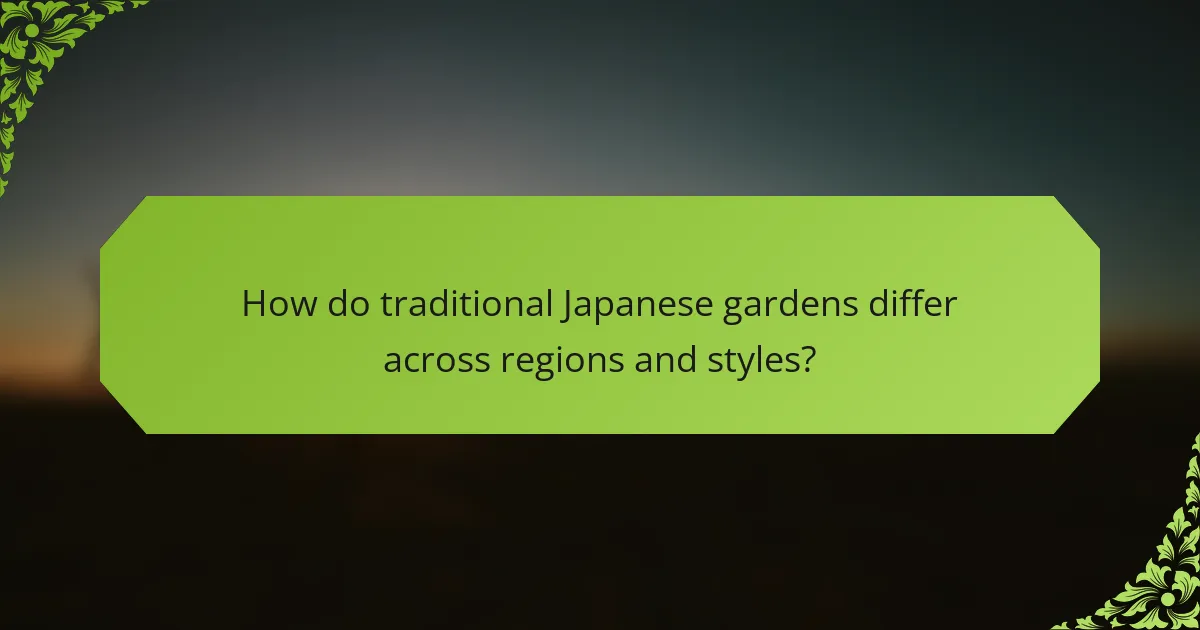
How do traditional Japanese gardens differ across regions and styles?
Traditional Japanese gardens vary significantly across regions and styles, reflecting local aesthetics and cultural influences. Regional differences include the use of materials, plant selection, and design elements, while styles such as Zen, tea, and stroll gardens emphasize unique philosophies and purposes. For instance, Zen gardens prioritize simplicity and meditation, whereas stroll gardens promote leisurely exploration. Additionally, climate impacts plant choices, leading to distinct regional flora. These variations contribute to the rich tapestry of Japanese garden design, showcasing the interplay between nature and culture.
Which unique features can be found in Kyoto-style gardens?
Kyoto-style gardens feature unique elements that emphasize natural beauty and tranquility. These gardens often include carefully arranged rocks, water features, and meticulously pruned plants. The use of moss, gravel, and lanterns adds to their serene aesthetic. Additionally, the layout encourages contemplation and harmony with nature, reflecting deep cultural significance in Japanese tradition.
What rare plants are often incorporated into specific garden designs?
Rare plants often incorporated into traditional Japanese gardens include the Japanese maple, moss, and black bamboo. These plants enhance the garden’s aesthetic and cultural significance. The Japanese maple, known for its vibrant foliage, brings seasonal color. Moss creates a lush, serene ground cover, while black bamboo adds vertical interest and elegance.
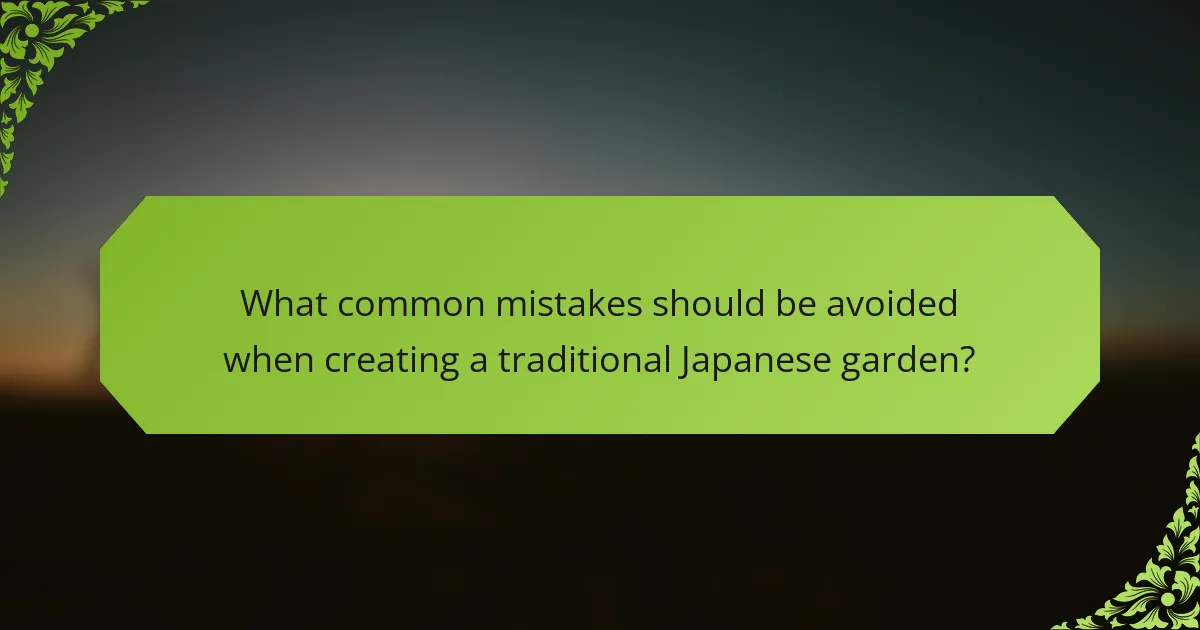
What common mistakes should be avoided when creating a traditional Japanese garden?
Common mistakes to avoid when creating a traditional Japanese garden include neglecting balance, overlooking seasonal changes, and using inappropriate materials.
Failing to achieve balance can disrupt the harmony that characterizes these gardens. Seasonal changes are crucial; gardens should reflect the beauty of each season, so planting choices must consider this aspect. Using materials that do not align with traditional aesthetics can detract from the garden’s authenticity and cultural significance.
Incorporating too many elements can lead to clutter, while underestimating the importance of water features may result in a lack of tranquility. Finally, ignoring maintenance practices can compromise the garden’s long-term health and beauty.
How can one ensure authenticity in design and plant selection?
To ensure authenticity in design and plant selection for traditional Japanese gardens, prioritize native species and historical accuracy. Emphasize the use of traditional materials, such as stone and bamboo, to reflect cultural significance. Engage with experts in Japanese garden design for guidance on aesthetic principles and maintenance practices. Incorporate seasonal changes and natural elements to enhance authenticity.
What are expert tips for integrating modern elements without losing tradition?
Integrating modern elements into traditional Japanese gardens requires careful consideration to maintain their cultural significance. Focus on blending contemporary design with classic aesthetics, ensuring harmony and balance.
Incorporate modern materials, such as glass or steel, while respecting traditional forms. Use minimalist furniture to enhance functionality without overwhelming the landscape. Consider sustainable practices, like native plant selection, to promote ecological balance.
Preserve key traditional features, such as stone lanterns and water elements, as focal points. This maintains cultural relevance while allowing for innovative expressions. Regular maintenance practices should adapt to include modern tools for efficiency, ensuring the garden remains a serene retreat.
